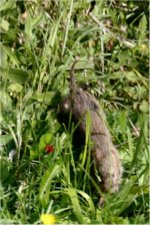Farnboro John
Well-known member
Mark Carwardine has an interesting piece on the ethics of wildlife photos in this month's BBC Wildlife. Not so much the disturbance of real wildlife - he pretty much takes the inappropriateness of that for granted - but the more subtle aspects such as baiting, a bit on how much photoshopping is acceptable and then outright fakery such as zoo photos or hired photographic models, with a side-swipe at the naff conditions some of the latter are kept in between shoots.
I use bait occasionally (more often for small mammals than for larger ones though I've certainly put stuff out for boars from time to time) but other than that I do very little. My one aberration is the attached pic of a Field Vole. It is one vole, but one shot cut the head off and the next chopped its back end off (fast moving subject) so....
What do others do/think?
John
I use bait occasionally (more often for small mammals than for larger ones though I've certainly put stuff out for boars from time to time) but other than that I do very little. My one aberration is the attached pic of a Field Vole. It is one vole, but one shot cut the head off and the next chopped its back end off (fast moving subject) so....
What do others do/think?
John





